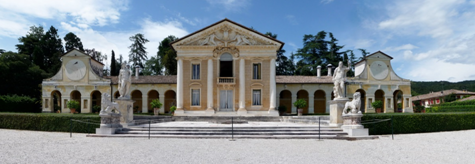
Villa
USINFO | 2013-10-23 15:10

A villa was originally an ancient Roman upper-class country house. Since its origins in the Roman villa, the idea and function of a villa have evolved considerably. After the fall of the Roman Republic, villas became small farming compounds, which were increasingly fortified in Late Antiquity, sometimes transferred to the Church for reuse as a monastery. Then they gradually re-evolved through the Middle Ages, into elegant upper-class country homes. In modern parlance 'villa' can refer to a various types and sizes of residences, ranging from the suburban "semi-detached" double villa to residences in the wildland-urban interface.
The term “villa” is used to refer to a variety of structures. The meaning is usually clear from the context, and many senses of the word are generally meant to imply luxury and occupancy by the upper or middle classes. Because of the dilution of the meaning of this word, it can sometimes be confusing when someone talks about a “villa,” especially if he or she is from a region of the world where the term may be used differently.
The original villas were country estates built by the Romans. A Roman villa consisted of a large central building with amenities like hot water, surrounded by outbuildings including stables, storage warehouses, wine pressing facilities, and so forth. The structures were surrounded by beautifully landscaped gardens and working farmlands, and managed primarily by servants. Some Roman villas were close to urban areas, allowing for a quick visit, while others were more remote, and used primarily as leisure homes in the hot summer months.
One of the key characteristics of Roman villas is that they were designed to be self sufficient, which proved to be very valuable when the Roman Empire began to collapse. Some villas were looted and destroyed, but others supported small communities that turned them into fortified settlements to defend themselves from invaders. Very few extant examples of villas from the Roman period still exist, but numerous archaeological expeditions have uncovered traces of them, along with information about how the Romans lived.
The European obsession with the Roman Empire as the peak of civilization led to a villa mania in the Renaissance, when many wealthy Europeans began building replicas of Roman villas. These villas also took the form of country estates, with more of a focus on leisure than self-sufficiency. The homes often had Roman or Italianate influences, and they were also surrounded by elaborate gardens and leisurely diversions, such as stables.
The sense of “villa” as a country estate is still common in many regions of the world. However, in the late 1800s, the term also came to be used to describe suburban homes on landscaped plots. These villas lacked the large grounds of country villas, although many of them were quite pretentious. Over time, the usage of the word came to be more and more corrupted, with semi-detached homes and much simpler homes being considered “villas,” along with more expansive luxury homes such as the vacation villas which line the coastlines of warm climates.
Share this page



















